2012 Hyundai Sonata park assist
[x] Cancel search: park assistPage 259 of 363
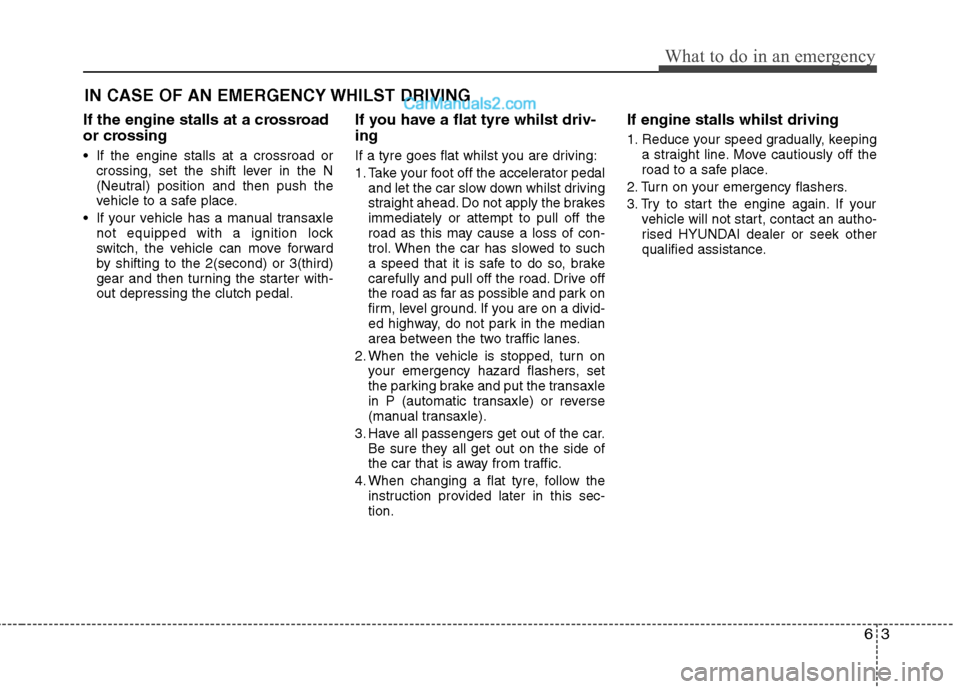
63
What to do in an emergency
IN CASE OF AN EMERGENCY WHILST DRIVING
If the engine stalls at a crossroad
or crossing
If the engine stalls at a crossroad or crossing, set the shift lever in the N
(Neutral) position and then push the
vehicle to a safe place.
If your vehicle has a manual transaxle not equipped with a ignition lock
switch, the vehicle can move forward
by shifting to the 2(second) or 3(third)
gear and then turning the starter with-out depressing the clutch pedal. If you have a flat tyre whilst driv- ing
If a tyre goes flat whilst you are driving:
1. Take your foot off the accelerator pedal
and let the car slow down whilst driving
straight ahead. Do not apply the brakesimmediately or attempt to pull off the
road as this may cause a loss of con-
trol. When the car has slowed to such
a speed that it is safe to do so, brake
carefully and pull off the road. Drive off
the road as far as possible and park on
firm, level ground. If you are on a divid-
ed highway, do not park in the median
area between the two traffic lanes.
2. When the vehicle is stopped, turn on your emergency hazard flashers, set
the parking brake and put the transaxle
in P (automatic transaxle) or reverse
(manual transaxle).
3. Have all passengers get out of the car. Be sure they all get out on the side of
the car that is away from traffic.
4. When changing a flat tyre, follow the instruction provided later in this sec-tion. If engine stalls whilst driving
1. Reduce your speed gradually, keeping
a straight line. Move cautiously off the
road to a safe place.
2. Turn on your emergency flashers.
3. Try to start the engine again. If your vehicle will not start, contact an autho-
rised HYUNDAI dealer or seek other
qualified assistance.
Page 260 of 363

What to do in an emergency
4
6
IF THE ENGINE WILL NOT START
If engine doesn't turn over or
turns over slowly
1. If your vehicle has an automatic
transaxle, be sure the shift lever is in N
(Neutral) or P (Park) and the emer-
gency brake is set.
2. Check the battery connections to be sure they are clean and tight.
3. Turn on the interior light. If the light dims or goes out when you operate the
starter, the battery is discharged.
4. Check the starter connections to be sure they are securely tightened.
5. Do not push or pull the vehicle to start it. See instructions for "Jump starting". If engine turns over normally but
does not start
1. Check fuel level.
2. With the ignition switch in the LOCK
/OFF position, check all connectors at
the ignition coils and spark plugs.
Reconnect any that may be discon-
nected or loose.
3. If the engine still does not start, call an authorised HYUNDAI dealer or seek
other qualified assistance.
WARNING
If the engine will not start, do not
push or pull the vehicle to start it.This could result in a collision or
cause other damage. In addition,
push or pull starting may cause the
catalytic converter to be over-
loaded and create a fire hazard.
Page 261 of 363
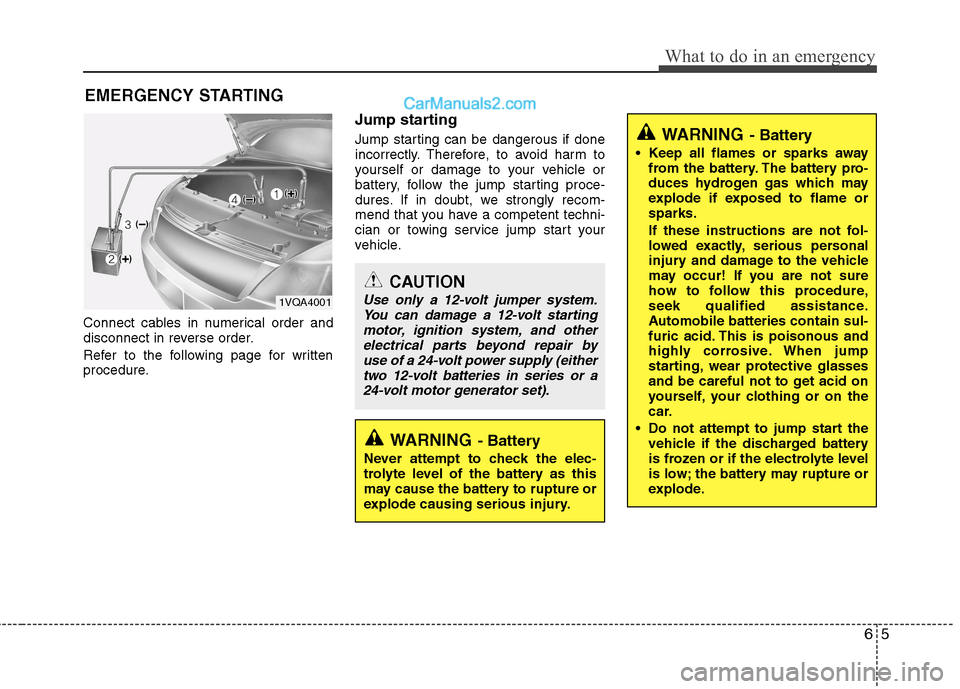
65
What to do in an emergency
EMERGENCY STARTING
Connect cables in numerical order and
disconnect in reverse order.
Refer to the following page for written
procedure. Jump starting
Jump starting can be dangerous if done
incorrectly. Therefore, to avoid harm to
yourself or damage to your vehicle or
battery, follow the jump starting proce-
dures. If in doubt, we strongly recom-
mend that you have a competent techni-
cian or towing service jump start your
vehicle.
CAUTION
Use only a 12-volt jumper system.
You can damage a 12-volt startingmotor, ignition system, and other
electrical parts beyond repair byuse of a 24-volt power supply (eithertwo 12-volt batteries in series or a24-volt motor generator set).
WARNING - Battery
• Keep all flames or sparks away from the battery. The battery pro-
duces hydrogen gas which may
explode if exposed to flame orsparks.
If these instructions are not fol-
lowed exactly, serious personal
injury and damage to the vehicle
may occur! If you are not sure
how to follow this procedure,
seek qualified assistance.
Automobile batteries contain sul-
furic acid. This is poisonous and
highly corrosive. When jump
starting, wear protective glasses
and be careful not to get acid on
yourself, your clothing or on the
car.
Do not attempt to jump start the vehicle if the discharged battery
is frozen or if the electrolyte level
is low; the battery may rupture or
explode.
WARNING - Battery
Never attempt to check the elec-
trolyte level of the battery as this
may cause the battery to rupture or
explode causing serious injury.
1VQA4001
Page 263 of 363
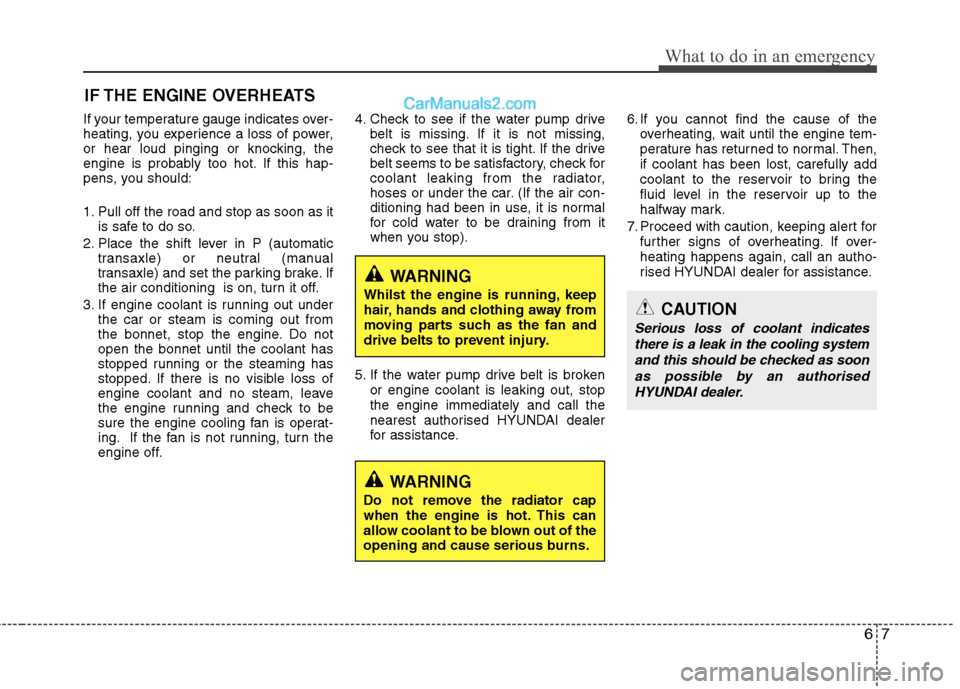
67
What to do in an emergency
IF THE ENGINE OVERHEATS
If your temperature gauge indicates over-
heating, you experience a loss of power,
or hear loud pinging or knocking, the
engine is probably too hot. If this hap-
pens, you should:
1. Pull off the road and stop as soon as it is safe to do so.
2. Place the shift lever in P (automatic transaxle) or neutral (manual
transaxle) and set the parking brake. If
the air conditioning is on, turn it off.
3. If engine coolant is running out under the car or steam is coming out from
the bonnet, stop the engine. Do notopen the bonnet until the coolant has
stopped running or the steaming has
stopped. If there is no visible loss of
engine coolant and no steam, leave
the engine running and check to be
sure the engine cooling fan is operat-
ing. If the fan is not running, turn the
engine off. 4. Check to see if the water pump drive
belt is missing. If it is not missing,
check to see that it is tight. If the drive
belt seems to be satisfactory, check for
coolant leaking from the radiator,
hoses or under the car. (If the air con-
ditioning had been in use, it is normal
for cold water to be draining from it
when you stop).
5. If the water pump drive belt is broken or engine coolant is leaking out, stop the engine immediately and call the
nearest authorised HYUNDAI dealer
for assistance. 6. If you cannot find the cause of the
overheating, wait until the engine tem-
perature has returned to normal. Then,if coolant has been lost, carefully add
coolant to the reservoir to bring the
fluid level in the reservoir up to the
halfway mark.
7. Proceed with caution, keeping alert for further signs of overheating. If over-heating happens again, call an autho-
rised HYUNDAI dealer for assistance.
WARNING
Whilst the engine is running, keep
hair, hands and clothing away from
moving parts such as the fan and
drive belts to prevent injury.
WARNING
Do not remove the radiator cap
when the engine is hot. This can
allow coolant to be blown out of the
opening and cause serious burns.
CAUTION
Serious loss of coolant indicates there is a leak in the cooling systemand this should be checked as soonas possible by an authorised HYUNDAI dealer.
Page 327 of 363
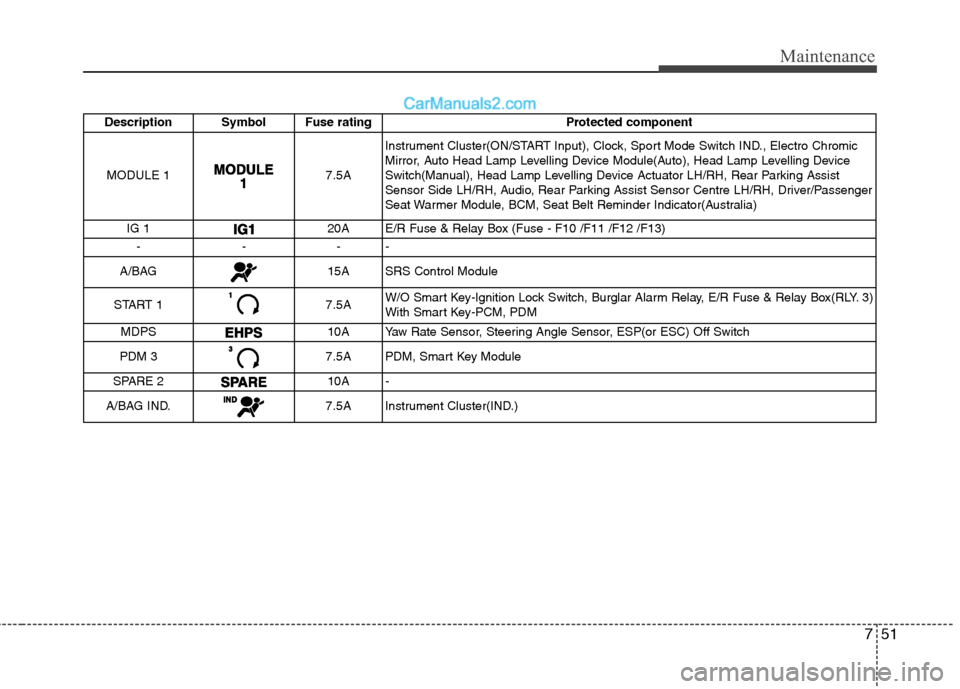
751
Maintenance
Description Symbol Fuse rating Protected componentMODULE 1
7.5A Instrument Cluster(ON/START Input), Clock, Sport Mode Switch IND., Electro Chromic
Mirror, Auto Head Lamp Levelling Device Module(Auto), Head Lamp Levelling Device
Switch(Manual), Head Lamp Levelling Device Actuator LH/RH, Rear Parking Assist
Sensor Side LH/RH, Audio, Rear Parking Assist Sensor Centre LH/RH, Driver/Passenger
Seat Warmer Module, BCM, Seat Belt Reminder Indicator(Australia)
IG 1
20A E/R Fuse & Relay Box (Fuse - F10 /F11 /F12 /F13)
--- -
A/BAG
15A SRS Control Module
START 1
7.5A W/O Smart Key-Ignition Lock Switch, Burglar Alarm Relay, E/R Fuse & Relay Box(RLY. 3)
With Smart Key-PCM, PDM
MDPS
10A Yaw Rate Sensor, Steering Angle Sensor, ESP(or ESC) Off Switch
PDM 3
7.5A PDM, Smart Key Module
SPARE 2
10A -
A/BAG IND.
7.5A Instrument Cluster(IND.)
Page 360 of 363
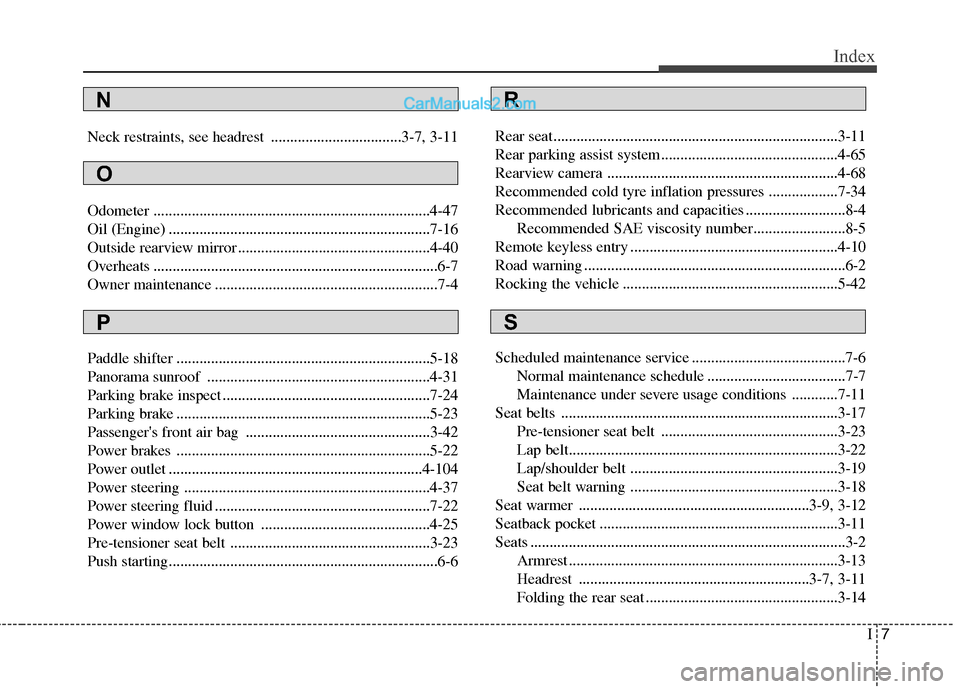
I7
Index
Neck restraints, see headrest ..................................3-7, 3-11
Odometer ........................................................................4-47
Oil (Engine) ....................................................................7-16
Outside rearview mirror ..................................................4-40
Overheats ..........................................................................6-7
Owner maintenance ..........................................................7-4
Paddle shifter ..................................................................5-18
Panorama sunroof ..........................................................4-31
Parking brake inspect ......................................................7-24
Parking brake ..................................................................5-23
Passenger's front air bag ................................................3-42
Power brakes ..................................................................5-22
Power outlet ..................................................................4-104
Power steering ................................................................4-37
Power steering fluid ........................................................7-22
Power window lock button ............................................4-25
Pre-tensioner seat belt ....................................................3-23
Push starting......................................................................6-6 Rear seat..........................................................................3-11
Rear parking assist system ..............................................4-65
Rearview camera ............................................................4-68
Recommended cold tyre inflation pressures ..................7-34
Recommended lubricants and capacities ..........................8-4
Recommended SAE viscosity number........................8-5
Remote keyless entry ......................................................4-10
Road warning ....................................................................6-2
Rocking the vehicle ........................................................5-42
Scheduled maintenance service ........................................7-6 Normal maintenance schedule ....................................7-7
Maintenance under severe usage conditions ............7-11
Seat belts ........................................................................3-17 Pre-tensioner seat belt ..............................................3-23
Lap belt......................................................................3-22
Lap/shoulder belt ......................................................3-19
Seat belt warning ......................................................3-18
Seat warmer ............................................................3-9, 3-12
Seatback pocket ..............................................................3-11
Seats ..................................................................................3-2 Armrest ......................................................................3-13
Headrest ............................................................3-7, 3-11
Folding the rear seat ..................................................3-14
O
P
NR
S